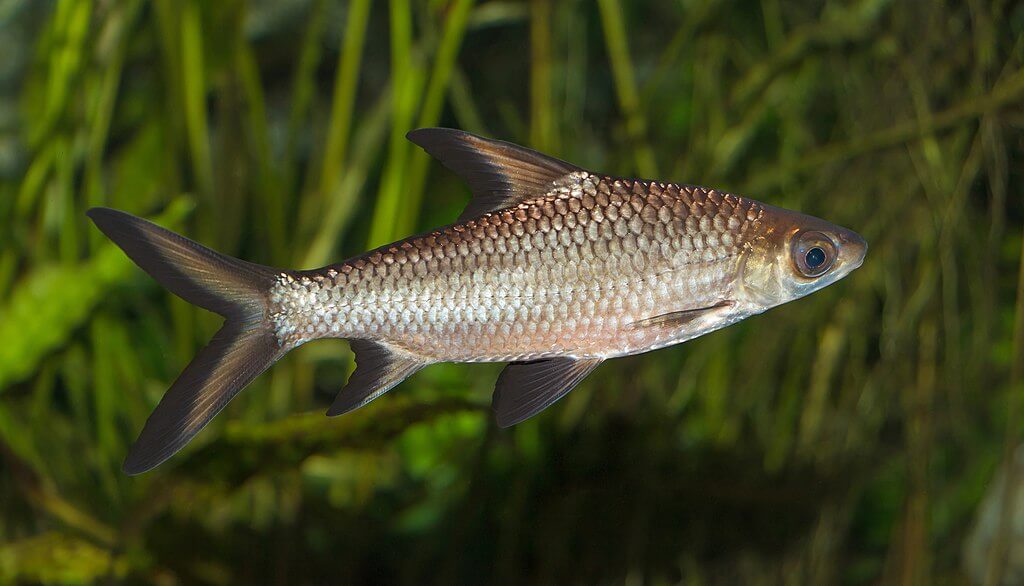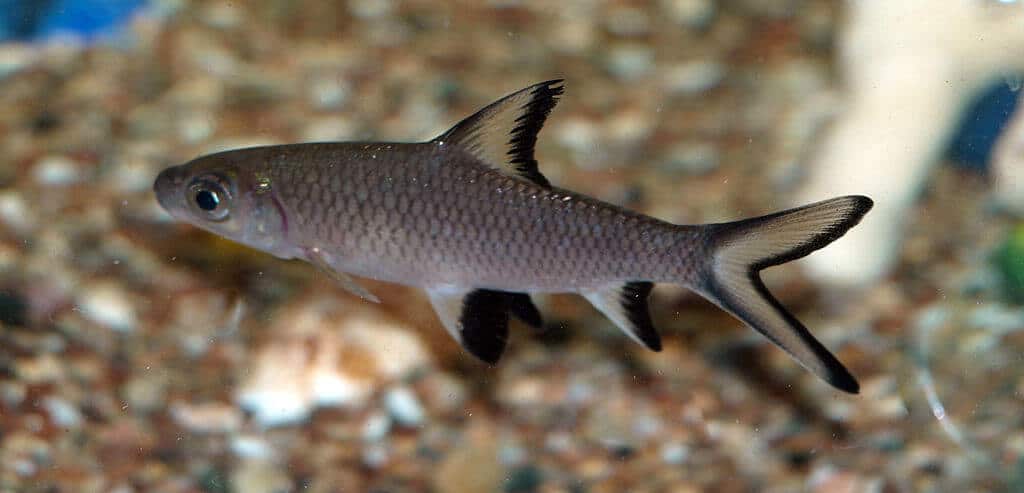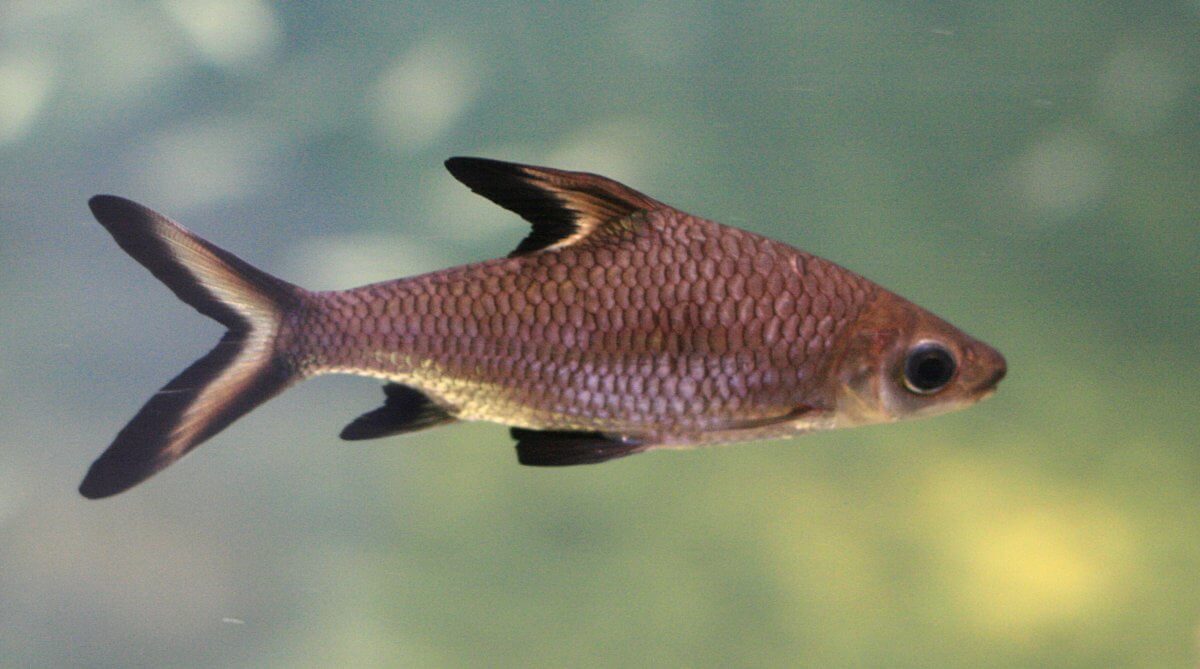For any aquarist looking to add a new freshwater shark to jazz up their tank, the Bala Shark is a popular choice. However, this Southeast Asian species is quite large, so we recommend it only for those with some prior experience in this hobby.
With that said, Bala Sharks have a beautiful appearance and will make any home aquarium look more attractive. They are generally affable and relatively active, which is always a plus point for an interesting tank.
If you think that this fish might be the perfect one for you, read on to learn more about them. We will look at their typical behavior, tank requirements, tankmates, dietary needs, and even breeding. Let’s go!
| Category | Rating |
| Scientific Name: | Balantiocheilus melanopterus |
| Common Names: | Bala shark, Silver Bala, Silver Shark, Hangus, Tricolor Shark, Tricolor Minnow, Malaysian Shark |
| Care Level: | Intermediate |
| Temperament: | Peaceful |
| Size: | Up to 12 inches or 25-30 cm |
| Color: | Tri-color of black, silver, and yellow |
| Life Expectancy: | Up to 10 years |
| Diet: | Omnivore |
| Family: | Cyprinidae |
| Tank Size: | Minimum 150 Gallons |
| Tank Setup: | Requires open swimming space |
Table of Contents
Species Overview
Part of the Cyprinidae family, the Bala Shark (Balantiocheilos melanopterus) can naturally be found in the rapid rivers across Southeast Asia. From Thailand and Cambodia, to Malaysia and Kalimantan.
Some people also call them the Silver Bala or Silver Shark. Meanwhile, Tricolor Shark and Tri Color Minnows are also common nicknames for this species.
Even though it’s named a shark, like other freshwater sharks, this fish’s only common trait with the larger species is its pronounced dorsal fin. In fact, they are actually quite friendly and will tolerate most other fishes.
Unfortunately, Bala Shark is now considered an endangered species as its population declined by half in the last decade. There are continuously less and less of them that can be found in the wild. Most of these sharks in home aquariums are usually bred in commercial farms.
Typical Behavior
You will find that the Bala Shark likes to travel in schools, which is partly why it is best to keep them in multiples! This fish is active and may even jump. Therefore, we recommend having a lid to close your aquarium and prevent any accidents.
These freshwater sharks also enjoy having plenty of hiding nooks, which you can provide through plants and roots.
While they are not aggressive by nature, remember that they are quite large in size. As a result, they may eat a lot and even take the food from smaller fish. They can also eat these small fishes, especially if they appear smooth and sleek.
General Appearance
Perhaps one of the most defining traits of Bala Sharks is its standing and captivating single dorsal fin. In addition, they have a torpedo-shaped body and fins bearing yellow stripes and black edges. The two ventral fins are small and usually solid-colored, while the anal fin is even smaller.
This fish is also known to have dense scales that will reflect lights in a truly scintillating manner. Their large eyes will help them hunt and take in their surrounding environment.
In terms of size, the wild fishes can grow to 14 inches, while those living in an aquarium are usually smaller. These ones can grow up to 12 inches, which in itself is still quite large.
Natural Habitat and Tank Setup

In the wild, Bala Sharks can be found in the middle regions of fast-flowing rivers in Southeast Asia, instead of the top or bottom. This is because they spend a lot of their time swimming around the river.
Water floors tend to vary from one region to another and depend if they are living in a river or lake. However, the Bala Shark likes to live where the natural substrate consists of both mud and rocky pebbles. It would be ideal if you could simulate this condition in your aquarium.
Best Tank Conditions
In trying to make the best possible home for your Shark, it is crucial to use a powerful filtration system. This will recreate the fast-flowing waters of their natural habitat. Meanwhile, the substrate should be around 1cm in thickness and be made up of dark pebbles.
Keep the water temperature around 77°F, water acidity between 6.5 to 8.0, and hardness of 10-13 dGH. The lighting condition should not be a problem as any regular tank lamp would suffice. But you should turn it on for at least 8 hours every day.
You should not worry about giving too many plants as they love swimming around. Having free space is more important to allow them to stay active. On a similar note, remember that this fish may occasionally like to jump! We’re going to reiterate the need for an aquarium lid.
Of course, you can still have plants inside the tank. We recommend plants like Anubias that you can plant around the edges, which will not disrupt the swimming space.
Bala Shark Tank Size
How big should your aquarium be to keep a Bala Shark? Start with a minimum of 45 gallons and increase as they grow larger. The best tank for adult fish is at least 150 gallons and 5 feet long. They are active swimmers and having all of this space is crucial!
You may choose to keep more than one of them in the same aquarium, which is okay. In fact, they do enjoy shoaling. Just make sure the tank is large enough and you provide around 45 gallons for every Shark.
Care Guide

The good thing about this species is that they are relatively hardy and not vulnerable to any specific diseases. However, they are sensitive to water changes and you should try to keep it nice, clean, and stable.
You can keep Bala Sharks happy and healthy by conducting regular partial water changes. This means changing around 25% of the water each week. Plus, feeding them properly is a must! Malnutrition and poor food quality may disrupt their digestive system and cause them to die early.
Of course, they’re not immune to common diseases like ich, dropsy, and parasites. You can treat them like any other fish if they do contract infection in any of these diseases. Be sure to observe them carefully so you can notice as soon as something is up.
Please take the utmost care when creating and maintaining a healthy environment for your fish. In the right tank where they feel comfortable ad happy, this Shark can last up to 10 years.
Food and Diet
As omnivores, Bala Sharks will eat pretty much anything you feed them, meat or plant, live or frozen. The wild ones generally feed on insects, larvae, algae, and other plant parts. But you can feed your aquarium Sharks with any live or dried alternatives.
We recommend using high-quality pellets or flakes as their main diet. Supplement this for a little bit of variety with bloodworms and vegetables. You can even toss in chopped-up fruits and green sometimes; it will help keep them strong and healthy.
The Bala Shark is quite large for aquarium fish, which means they need plenty of protein in their diet. You can feed them shrimp, for example.
Try to feed the fish around 3 times a day in small portions, providing just enough for them to finish in two minutes. As long as you feed them well with natural foods, you should not need to provide any supplements.
Bala Shark Tankmates
Despite having the name shark, they are quite a peaceful species, and finding suitable tankmates should not prove too difficult. You can keep them with other non-aggressive species. This includes Rainbowfish, Gourami, and even Tetra. Other Cyprinids can also be a good choice.
The only thing to keep in mind is to consider the size and temperament of the other fishes. We don’t recommend predatory species like large cichlids, or tiny ones like the neon tetras. Oh, you might want to know that breeding other fish with a Bala Shark present is unwise. They will probably eat the baby fish!
In addition, you should not keep non-fish species together with this fish. It is likely they will feed on the smaller creatures, especially shrimps, and show their aggressive side.
Keeping Multiple Bala Sharks Together
Some freshwater species prefer spending their time alone, thanks to their solitary nature. On the other hand, others like the Bala Shark actually thrive well in a community. We advise keeping a minimum of 4 Sharks together.
Being able to shoal will help reduce any aggressive behavior, or for one of them to be the dominant one. Don’t forget that there should be enough space for all of these fishes to swim freely!
Breeding Bala Sharks
Good news for hobbyists who enjoy breeding their fish at home: Bala Sharks breed easily. Although, you should still note that their size plays a huge part in how you should handle it.
Prepare them before they reach puberty and separate them as 4-months old fishes. It can be tricky to tell the males and females apart, but male Sharks are usually bigger. Meanwhile, female ones usually have round bellies.
You will need a 65-gallon tank for spawning with water of around 77°F. You can add some décor to the sides, but make sure they are not taking up the swimming space. Also, adding a special net may make the entire process simpler.
When you are ready to stimulate spawning, slowly raise the temperature to 82°F. Gradual increase is the key as you would not want sudden spikes in water conditions to disrupt the process. These fishes usually spawn in the morning for a few hours. The males will then fertilize the eggs.
It is also good to have a strong water flow at this stage, which will help to distribute the male fish’s milt more evenly. If you do this, remember to use a sponge filter afterward so that the fry won’t get sucked into it.
Remove the parent Bala Sharks immediately. The same applies to any unfertilized eggs, which will appear white. At this point, you should renew around 40% of the water, turn on the filter, and maybe even add antibacterial solutions.
24 hours later, larvae will appear. These will become fry after around three or four days. Feeding them is also quite simple, and we recommend providing ciliates in the beginning. Once the fry are at least 4 days old, they can start eating nauplii of artemia or cyclops.
The most important thing to note, once these babies grow larger, is that they may develop at different rates. Some juvenile Bala Sharks will be bigger. You may need to separate them into a different tank to avoid aggression towards the smaller ones.
Conclusion: Should You Get Bala Sharks?
When considering the addition of the Bala Shark to your tank, their simple yet beautiful appearance will often charm most aquarists. If you have enough space at home for a large tank and at least a few years of fishkeeping experience, we think this fish will be a lovely choice for you!
They are quite easy to take care of if you provide the right foods and water conditions. Not to mention that breeding is relatively simple.






